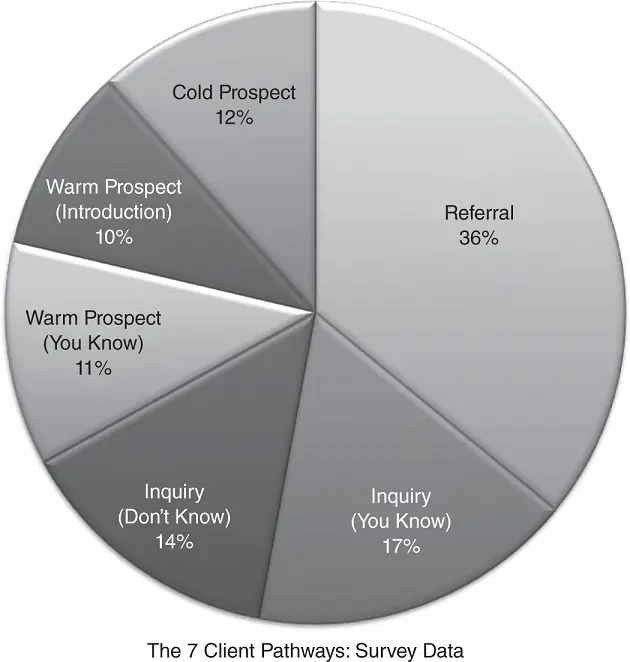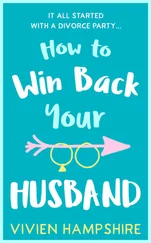Molly's story may not be that familiar to many of us; most of us don't prospect door to door. But it does fit into one of the traditional client pathways; it just may look a little different in your profession. Understanding these traditional pathways is essential to understanding the importance of the five rainmaker skills that we'll soon discuss.
The Seven Most Common Client Pathways
Over a cocktail at a dimly lit bar, I'll confess that I've spent more time than I care to admit thinking about where clients come from and how we can get more of them . Reflecting upon my own experiences and on hundreds of stories from others, I have discovered that clients arrive via seven predictable pathways:
1 Repeat business (from a satisfied client)
2 Referrals (from a satisfied client, trusted colleague, friend, or acquaintance)
3 Inquiries (from someone you know)
4 Inquiries (from someone you don't know)
5 Warm prospecting (with someone you know)
6 Warm prospecting (with an introduction)
7 Cold prospecting (with no introduction)
These client pathways are ranked by their relative success rate. The first pathway, repeat business, has the highest success rate. The last pathway, cold prospecting (as in Molly's example), has the lowest success rate. Those pathways in between are arranged in an order of descending success rate. (See Figure 3.1.)
Why does repeat business have the highest success rate? As we discussed in the previous chapter, clients hire people who they know, respect, and trust. If we've done great work for a client in the past, there is a much greater chance they'll hire us again in the future or recommend us to others.
If you're cold prospecting, the prospective client doesn't know you, and has no reason yet to respect or trust you. They may eventually choose to work with you, but you'll have to allow time for the client to move through the milestones of the client's buying decision journey.
For some of us, a prospective client may not know anything about what we do, or how our service is remotely helpful. Thus, we've got some work to do and this will take time. It doesn't mean that prospecting doesn't work in our lines of work. It can work when done right. It's just that the success rates will typically be lower and the sales cycles longer.
In a market survey my firm recently conducted with professional service providers, the data aligns with my experience and observations. As illustrated in Figure 3.2, referrals and inquiries represent roughly two‐thirds of all new client business.

FIGURE 3.1The Seven Client Pathways

FIGURE 3.2The Seven Client Pathways Pie Chart
Where Clients Come From: The Seven Client Pathways
Every successful professional I speak with has stories about where their new clients come from. Each client story is different, but they have common themes. These themes are captured in these client pathways.
Pathway 1: Repeat Business (from a Satisfied Client)
This week I signed a new work agreement with a previous client for a coaching program for his consulting firm. I've known Paddy Fleming, the managing director, for about 20 years. We first met when we were both in our early 30s and my firm was doing some work with his.
At the time, Paddy was just getting started with his organization. Years later, Paddy was chosen by his firm's board of directors to be the managing director. When How Clients Buy was published, Paddy reached out to me to see if I would lead a client development workshop with his team. That was about 18 months ago. Last month, Paddy reached out again with a more extensive coaching program in mind.
The fastest work comes from those we have done good work for in the past. What I didn't appreciate earlier in my career is why this is so. Clients face a litany of risks they struggle to mitigate in hiring us: performance, cultural, reputational, financial, and career risks. These intangibles make it difficult in hiring us for the first time.
There are exceptions to this pathway that we'll discuss later on. Some of us provide services that a client hopes they will never need – and hopefully will never need a second time. Think about the clients of a bankruptcy attorney or a crisis PR consultant. If you do great work, hopefully the client will never need your services again. Yet, doing great work – even for once‐in‐a‐lifetime services – can lead to referrals. This leads us to the second pathway.
Pathway 2: Referrals (from a Satisfied Client, Trusted Colleague, Friend, or Acquaintance)
What's a prospective client to do if they haven't hired someone for a specific service before? Maybe they are looking for a web designer, or a financial planner. More often than not, they will ask around to see if someone they trust has a recommendation.
Referrals are the leading source of new business according to my survey, representing 36% of all new clients. This is two times higher than any of the other new client pathways. If we come highly recommended by someone who knows us, we've moved from home plate to second base, maybe even third. In the absence of a repeat client, a strong referral is the next fastest pathway.
The referral source is split roughly 60/40 between our client base (57%) and our professional network (39%). The leading source of referrals is from those we are currently working with or have worked with in the past. This, again, highlights the importance of doing great work.
The next leading source of referrals is from our professional network, or ecosystem: professionals outside of our firm with whom we have a close relationship. This ties into the importance of Rainmaker Skills 3 and 4: building your professional ecosystem and developing trust‐based relationships. Chuck McDonald – an attorney in Columbia, South Carolina, specializing in serving the needs of clients in the construction industry – puts it this way:
The best way to sell your services is not for you to sell your services, but to have someone else sell your services. Nobody wants to hear you say how good you are. It means so much more to have someone they trust say how good you are. Unless you screw up a good referral, you're going to get the business.
Pathway 3: Inquiries (from Someone You Know)
The next most common pathway is an inquiry from someone we know but have never worked with previously, similar to my friend John Senaldi's story from the previous chapter. Our survey data suggests that this pathway is the second leading source of nonrepeat client business at 17%, roughly half that of referrals.
The client's buying decision journey is often nonlinear. We may meet someone, get to know them, they come to respect and trust us, but they are not in the market for what we do. Years later an opportunity arises where they find themselves in need of outside help, and you are top of mind. In this scenario, the risks a prospective client faces in hiring us are mitigated by the strength of our existing relationship.
Sarah is a friend of mine who is a young partner with one of the big four accounting firms. She loves classical music and serves as the treasurer on the nonprofit board of her city's symphony. Richard, one of her fellow symphony board members, is the CFO of a Fortune 500 consumer products company. Sarah and Richard have known each other for about three years since joining the nonprofit board, and work closely together on the board's audit committee.
Читать дальше














